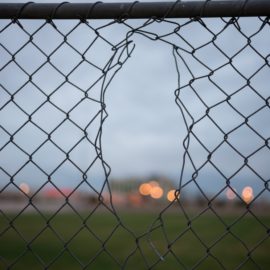

This article is an excerpt from the Shortform book guide to "The Stoic Challenge" by William B. Irvine. Shortform has the world's best summaries and analyses of books you should be reading.
Like this article? Sign up for a free trial here.
What is Stoicism’s adversity methodology? How do the Stoics handle adversity?
In The Stoic Challenge, William B. Irvine explains the Stoics’ core strategy of treating adversities as tests of character. He details how to make use of two psychological phenomena to change your relationship to hardship.
Let’s look at what the Stoics said about adversity.
How the Stoics Dealt With Adversity
Though we might handle adversity poorly by default, Irvine argues that anyone can learn to navigate her troubles more effectively. You can begin to do so by understanding two Stoicism adversity insights:
- Most things are out of our control. Other people, the weather, society, the world’s governmental and economic systems, the natural world—no single person has power over these things.
- How we respond to the world is in our control. While we can’t stop storms, wars, or social disasters at work, we can control how we respond to these events.
So instead of reacting poorly when adversity comes along, a Stoic would choose to consciously respond—first, by using a mental technique to bypass and defuse their reactive emotions, and then by looking for ways to overcome the problem. This strategy served the main aim of a Stoic’s life, which, according to Irvine, was to create and maintain inner tranquility.
According to Irvine, the Stoics’ key mental technique was simply to reframe the problem. That is, upon encountering a problem or obstacle, a Stoic would choose to view it as an opportunity to practice his Stoic virtues—resilience, resolve, resourcefulness, courage, and good humor. Doing this would improve both his psychological and practical responses to adversity:
- Psychologically, he would maintain emotional equanimity (or resolve) by choosing to respond rather than react to the problem. He would aim to prevent the arising of negative emotions like anger, frustration, or cowardice.
- Practically, greater resolve would afford him a clear mind with which to solve the problem, demonstrating his resourcefulness.
After reframing a problem, Irvine says, a Stoic would look for a resourceful way to solve it. This boils down to using your clear mind to find creative solutions, though Irvine doesn’t say exactly how to do so.
Why the Stoic Strategy Works
According to Irvine, this Stoic strategy for navigating adversity works by making use of one powerful psychological phenomenon: the framing effect. In short, this effect says that the way you interpret or frame something affects how you feel about it and, in turn, how you handle it. This is because different frames emphasize different aspects of a situation, and focusing on one aspect versus another changes how you relate to it.
For instance, perhaps you had to take physical fitness assessments as a child in school, including a running test. While some kids focus on how long and physically demanding the test is, others view it as a fun way to compete with friends and beat their previous times. Just by emphasizing different aspects of the run, each group experiences the same thing in different ways.
When it comes to more serious adversities, reframing can help you see a perceived problem as a chance to grow or even enjoy yourself. In a Stoic context, that’s the whole point of reframing: It helps you view and handle troubles in a way that bolsters your emotional tranquility and improves your practical outcomes.
(Shortform note: Framing doesn’t just affect the way you view adversity—it also plays an important role in decision-making. Another way to look at the framing effect is as a cognitive bias. That is, you only ever have limited information about a choice, and that information biases how you view your options. In Nudge, Richard H. Thaler and Cass R. Sunstein argue that this effect affords numerous opportunities to design the choices that we present people with in order to nudge them toward better decisions. In other words, framing operates on both a personal level, as Irvine explains, and on a systemic level, such as how the real estate market presents stock data and decisions to buyers and investors.)
How to Use the Stoic Reframing Strategy Today
Traditionally, Irvine explains, the Stoics would frame the adversities they encountered as tests put to them by the Roman head god, Jupiter. They believed that Jupiter showed his favor by testing people he thought capable of achieving excellence—so every adversity was an opportunity to prove your mettle. This framing gave a Stoic the strength to remain resolute and resourceful because he wouldn’t accept failing before his god.
Although the ancient Stoic mindset relied on belief in Jupiter, their method of approaching adversity doesn’t—it’s still valid, according to modern psychology. To use this method today, then, just find a different way to frame things that reproduces the motivation that the Jupiter frame gave the Stoics. Irvine offers two alternatives:
- If you follow Christianity, Islam, or Judaism, you can devise a frame that motivates you to prove yourself in the eyes of your god.
- If you follow no god or gods, you can assume that imaginary Stoic gods will test you. Irvine contends that while it may sound silly, this has a powerful motivating effect on the subconscious, and it’s the framing that he personally uses.
(Shortform note: For more alternative framings, you might look to bhakti yoga, a centuries-old Indian path to spiritual attainment that involves devotion to, traditionally, a personal deity, a guru, or the Divine in general. Some contemporary practitioners of bhakti yoga also advocate for devotion to universal values such as love and compassion. Drawing from this, you might craft a framing that appeals to your higher values or aspirations, rather than various gods that may not spark your motivation.)
In any case, Irvine says, you can then use the general form of the Stoics’ strategy: When adversity arises, immediately reframe the situation, and then attend to your emotional and practical responses to the problem.
Your emotional response is your first priority, according to Irvine. To prevent your reactive emotions from taking over, you must reframe things within five seconds. As we explained earlier, the key is to prevent negative emotions from arising in the first place.
(Shortform note: In Mindfulness in Plain English, Henepola Gunaratana asserts a slightly different perspective on emotional regulation. Like Irvine, he says that as soon as you recognize a reaction, such as the arising of ruminations on a fight with a loved one, you need to step back and view it from afar. However, whereas Irvine suggests immediately redirecting your emotional responses, Gunaratana says that the meditator’s mindset involves dropping expectations and accepting everything that arises, regardless of whether you want or like, for instance, the emotions swirling around inside of you. Accepting what arises means watching the reaction unfold from start to finish. Both of these methods have merit, so don’t hesitate to experiment and find what works for you.)
Irvine says that once you’ve attended to your emotional response, you can focus on your practical response by looking for a way to overcome the problem.
Over time, Irvine says, practicing this strategy will condition you to feel less frustration or anger when troubles come along. It’ll become habitual to maintain your tranquility and solve your problems, and your instinct to react emotionally will weaken over time. You might even begin to look forward to adversities—and that’s a sign that you’re well on the road to Stoic-style success.
(Shortform note: Irvine’s assertion that the Stoic strategy will become habit has an indirect empirical basis. A growing body of neuroscience research supports the notion that what we do repeatedly becomes more automatic—that is, ”what fires together, wires together.” Studies show that brain volume generally increases in the areas that correspond to different emotional regulation strategies and that the areas that grow depend on the strategy used. One such strategy, expressive suppression, involves feeling but not externalizing your emotional response to a situation. Regular expressive suppression correlates with an increase in the volume of the insula, a brain region involved in various cognitive and affective processes.)

———End of Preview———
Like what you just read? Read the rest of the world's best book summary and analysis of William B. Irvine's "The Stoic Challenge" at Shortform.
Here's what you'll find in our full The Stoic Challenge summary:
- How you can minimize suffering by reframing it
- How you can use the Stoics’ strategy in your everyday life
- Why you should take any good fortune in stride






